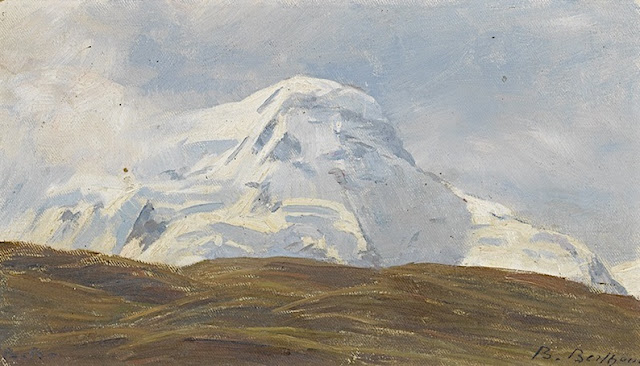In 1845 Roffiaen saw two paintings by Alexandre Calame at the Salon de Bruxelles. He was so impressed by them that the young Belgian was awarded a place to train in his new mentor’s Geneva studio for six months. His style and subject matter remained close to Calame’s throughout his life, but he travelled further afield to the Mediterranean. Roffiaen’s work was admired and collected by the royal families of Europe and this magnificent dawn view of Monte Rosa is probably the prototype version for a large two-and a half metre canvas, dated 1875, now in the Brussels museum together with several other pictures by him.
The mountain
The Pointe Dufour (4,634 m - 7,103ft), in german Dufourspitze, is the highest peak of Monte Rosa, (Mont Rose) a huge ice-covered mountain massif in the Alps. Dufourspitze is the highest mountain peak of both Switzerland and the Pennine Alps and is also the second-highest mountain of the Alps and Europe outside the Caucasus. It is located between Switzerland (Canton of Valais) and Italy (Piedmont and Aosta Valley). Following a long series of attempts beginning in the early nineteenth century, Monte Rosa's summit, then still called Hцchste Spitze, was first reached on 1 August, the Swiss National celebration day, in 1855 from Zermatt by a party of eight climbers led by three guides: Matthдus and Johannes Zumtaugwald, Ulrich Lauener, Christopher and James Smyth, Charles Hudson, John Birkbeck and Edward Stephenson.
The name Pointe Dufour or Dufour Spitze replaced the former name Höchste Spitze (English: Highest Peak) that was indicated on the Swiss maps before the Federal Council, on January 28, 1863, decided to rename the mountain in honor of Guillaume-Henri Dufour. Dufour was a Swiss engineer, topographer, co-founder of the Red Cross and army general who led the Sonderbund campaign. This decision followed the completion of the Dufour Map, a series of military topographical maps created under the command of Dufour.
The point just 80 m (260 ft) east of the Dufourspitze and only 2 metres lower, the Dunantspitze, was renamed in 2014 in honor of Henry Dunant, the main founder of the Red Cross.
The painter
Jean François Xavier Roffiaen was a Belgian landscape painter who specialized in painting Alpine landscapes. He followed his artistic studies at the Academy of Brussels (1839–1842), notably under the famous vedutiste, François Bossuet (1789–1889) who was responsible for teaching him perspective and who was the authority on landscapes and city views.
The years 1850–1860 were those of Roffiaen's greatest success, including numerous sales in Belgium, in Great Britain and in the United States, having works acquired by the Shah of Persia, by the Belgian and British royal houses, a study tour of Scotland commissioned by Queen Victoria, but which unfortunately never took place because of the sudden death of Albert, Prince Consort. His painting, constructed according to indefinitely repeated formulae and each year becoming a little more tired, finished however by wearying the art chroniclers : « Critics of the press have often reproached him for the bias he shows in his painting. M Roffiaen has ignored them, he has continued to accumulate landscapes of Belgium, Scotland, Switzerland, Germany, Italy, what do I know, combing them without rest, using the same formula, making do with the same sky, the same trees, the same rocks, unconcerned by the latitudes, according to the taste of a special public, who buy all of that and pay him handsomely. Leave M. Roffiaen alone, gentlemen of the press, he paints his little nature scenes one demands of him and knows well the reason why. »
(G. H., L’Organe de Namur et de la Province, 1874).
François Roffiaen is equally illustrious in the domain of natural sciences, to which Jules Colbeau (1823–1881) introduced him in his youth. While children the two companions already took delight in observing nature in the little property that Colbeau’s parents owned in the suburbs of Namur. Once adult, they took a journey together to Switzerland (1852) where they collected insects, butterflies and molluscs.












%20The%20Dom%20and%20Ta%CC%88schhorn%20above%20Zermatt-watercolour%2030.5%20x%2037.5%20cm.%20John%20Mitchell%20Fiene%20Arts%20%20London%20.jpg)






